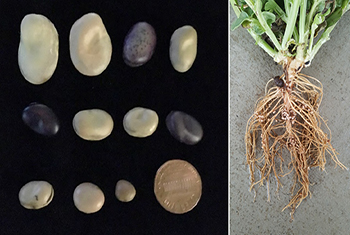
HIGHLY VARIABLE. Because fava beans have been cultivated for thousands of years, there is a range of seed sizes and plant characteristics. The nitrogen-fixing legume is adaptable to an impressive variety of soil and climatic conditions.
The fava bean (Vicia faba), also known as bell bean or horse bean, is one of many nitrogen fixing legumes used as a cover crop. It is frost tolerant, saline tolerant, has varieties that can be grown in cool seasons and warm seasons, produces abundant biomass, and has a stout, erect growth form that works well in cover crop mixes that include vining species such as hairy vetch (Vicia villosa) or Austrian winter peas (Pisum sativum).
There are thousands of cultivars and land races of fava beans adapted to an impressive variety of soil and climatic conditions. This may be due to the fava bean’s widespread use and long history of cultivation. It was historically grown as a dietary staple throughout Eurasia and Northern Africa, and the earliest evidence of cultivation was over 11,000 years ago in the Middle East.
The United States fava bean germplasm collection, managed by the Agricultural Research Service’s (ARS) Plant Germplasm Introduction and Testing Research Unit, has nearly 700 fava bean accessions from sixty countries, giving plant breeders a wide spectrum of forms and genetic traits to work with. With all the options available, finding the most adapted fava bean variety for a specific location can be a little tricky. Additionally, fava bean seed varies considerably in size, so finding a smaller seeded fava bean variety that can be mechanically planted easily and works well as a cover crop provides additional challenges.

BIOMASS BOSS. Four NRCS Plant Materials Centers compared commercially available fava bean cultivars and elite breeding lines developed by the ARS. Each PMC planted the fava beans in the fall and recorded emergence, winter and spring vigor, height, biomass, and nitrogen content.
To identify fava bean varieties with the most potential for cover cropping in the western United States, an adaptation trial was conducted at four NRCS Plant Materials Centers (PMC) in California, Nevada, Arizona, and Oregon. The study compared commercially available fava bean cultivars and nine elite breeding lines developed by the ARS. The four PMCs were well suited for this evaluation because the diversity in their winter temperatures, precipitation, and soils are representative of the variable growing conditions in the West.
Each PMC planted the fava beans in the fall and recorded emergence, winter and spring vigor, height, biomass, and nitrogen content. Several of the ARS breeding lines were superior in above ground biomass and nitrogen content compared to the commercial varieties, including Bell Bean which is a smaller seeded variety. The best performing lines from these trials will be registered with ARS' Germplasm Resources Information Network for further research and commercialization.
Researchers at California State University, Chico are also continuing the work of evaluating small seeded fava beans with the hope of achieving a more optimal balance of characteristics desired for a cover crop and the seed size needed for mechanical planting.
Find out more about fava beans, cover crops, and the NRCS Plant Materials Program:
Join the California PMC in a fava bean virtual field day on May 7, 2021. Preregistration is required.
For more information on the fava bean, please see the fava bean plant guide.
For commercial sources of cover crop seed, especially in western states, please see Technical Note No. 3: Cover Crop Seed Vendors for Western States.
For additional information on cover crops please see the Plant Materials Program cover crops and soil health website.
Technical information and guidance on the use of cover crops is also available on the Plant Materials Program website or contact your nearest NRCS field office.





